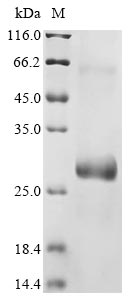This recombinant mouse protein PML is produced in an E. coli expression system and covers amino acids 60-243. The protein includes an N-terminal 10xHis-tag and a C-terminal Myc-tag, which should make purification and detection more straightforward. It comes with purity greater than 85% based on SDS-PAGE analysis, though this level appears adequate for most research applications. Important to note: this product is strictly for research use and cannot be used for diagnostic or therapeutic purposes.
PML protein plays what seems to be a critical role in cellular processes like apoptosis and senescence. It's involved in forming nuclear bodies, structures that appear essential for various pathways including DNA repair and antiviral defense mechanisms. Given its involvement in these processes, PML has become a significant focus in research areas related to cell cycle regulation and cancer biology.
Potential Applications
Note: The applications listed below are based on what we know about this protein's biological functions, published research, and experience from experts in the field. However, we haven't fully tested all of these applications ourselves yet. We'd recommend running some preliminary tests first to make sure they work for your specific research goals.
Based on the provided information, the recombinant mouse PML protein (amino acids 60-243) is unlikely to be correctly folded or bioactive without experimental validation. PML is a eukaryotic nuclear protein that requires proper folding and post-translational modifications (e.g., SUMOylation) for its function, which the E. coli expression system cannot provide. The partial length (60-243aa) may lack critical domains (e.g., full RING or coiled-coil regions) necessary for native structure. The dual tags (N-terminal 10xHis and C-terminal Myc) could sterically hinder folding, especially if they interfere with domain interactions. The purity >85% indicates some impurities, but does not guarantee correct folding. Without validation (e.g., circular dichroism for secondary structure, binding assays with known partners), the protein's folding status and bioactivity remain uncertain. Therefore, while the protein might fold under ideal conditions, the expression system and tags pose significant risks.
1. Protein-Protein Interaction Studies
This dual-tagged PML fragment can be used in pull-down assays only if correct folding is verified. If misfolded, interactions may be tag-mediated or non-specific, leading to false positives. The tags allow immobilization and detection, but biologically relevant binding partners might not bind without native conformation. It is recommended to validate folding first and include controls (e.g., tag-only proteins or full-length PML) to ensure specificity. Results should be interpreted cautiously without folding confirmation.
2. Antibody Development and Validation
This recombinant PML fragment can serve as an immunogen, but if misfolded, antibodies may primarily recognize linear epitopes or tags rather than conformational epitopes of native PML. The dual tags could dominate the immune response, reducing utility for detecting endogenous PML. For reliable antibodies, validate using tag-free PML or confirm specificity with mouse cell extracts. The high purity is beneficial, but does not ensure antigen quality.
3. Structural and Biochemical Characterization
This PML fragment is unsuitable for detailed structural studies without tag removal and folding validation. The dual tags may alter biophysical properties (e.g., in circular dichroism or dynamic light scattering), and the purity >85% is suboptimal for high-resolution techniques. If misfolded, stability data will be invalid. For meaningful insights, remove tags and confirm native-like structure through functional assays.
4. ELISA-Based Quantitative Assays
This recombinant PML can be used in ELISA assays, but the tags may affect antibody binding, leading to inaccurate quantification. If misfolded, it may not serve as a reliable standard for native PML detection. Validate the assay with spike-recovery experiments using mouse samples to ensure accuracy. The dual tags offer detection flexibility but require careful optimization to avoid interference.
Final Recommendation & Action Plan
To ensure reliable results, first validate the folding and bioactivity of the recombinant PML protein using techniques such as circular dichroism to assess secondary structure, size-exclusion chromatography to check oligomerization, and binding assays with known interactors (e.g., other nuclear proteins). Given the risks from the E. coli expression system and dual tags, consider using eukaryotic-expressed PML for critical applications. If using this protein, remove the tags via proteolytic cleavage (if possible) and re-purify for functional studies. For antibody development, characterize antibodies thoroughly against tag-free PML or endogenous protein. Always include controls, such as tag-only proteins and full-length PML standards, to account for artifacts. Prioritize folding validation before any quantitative or interaction-based applications.






